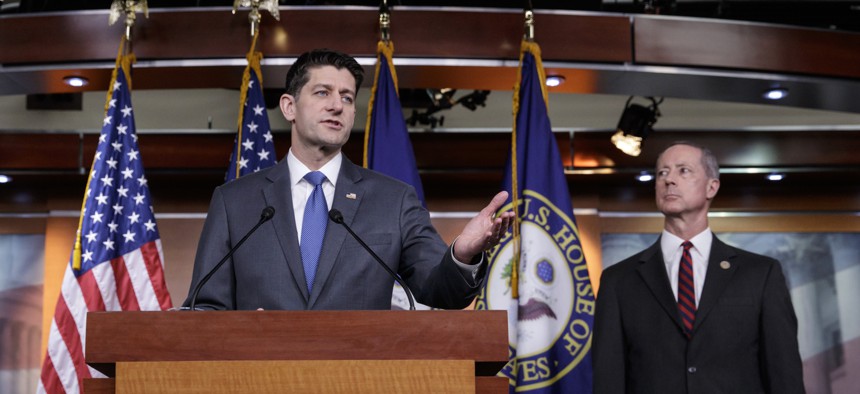
Speaker of the House Paul Ryan, R-Wis., joined by House Armed Services Committee Chairman Mac Thornberry, R-Texas, right, speaks about the massive government spending bill moving through Congress. J. Scott Applewhite/AP
Defense Hawks Soak Up Defense Spending Win. Now What?
The backs of the men and women in uniform — which defense hawks say have so long borne the weight of Congress’s fiscal stumbles — helped carry the $1.3-trillion 2018 spending bill over a key hurdle on Thursday.
Defense hawks championed the passage of a $1.3 trillion spending bill in the House that would dramatically increase funding for the military, nearly seven years after federal spending caps were put in place. Members of Congress on Thursday approved an omnibus appropriations package that includes than $650 billion for the U.S. Defense Department, and used the bill’s robust defense spending point as a top selling point.
Republican leaders, like House Speaker Paul Ryan, R-Wisc. — who doesn’t often delve into defense issues — said passing the bill came down to a “fundamental question” of “whether we’re going to preserve the primacy of the American military in the 21st century. That’s really what’s going on right here.”
“Yes, this bill is critical for many, many other reasons,” Ryan said, noting it includes funding to address the national opioid epidemic and build fencing along the southern U.S. border. But, he said, “what this bill is ultimately about — what we fought for, for so long — is finally giving our military the tools and the resources it needs to do the job.”
Rep. Mac Thornberry, R-Texas, chairman of the House Armed Services Committee, praised Ryan and the budget deal.
“Throughout this process fixing our military has been the most important thing, the most important priority the speaker has worked for," Thornberry said while standing beside Ryan in a joint press appearance.
The House’s federal spending bill includes $589.5 billion for the Pentagon’s base budget and $65.2 billion forthe off-books “overseas contingency operations”, or OCO fund, which is used to pay for operations in Afghanistan, Iraq, Syria and Africa. It also boosts spending for missile defense, fighter jets, and more. With $700 billion in total defense-related spending coming, the military’s service branch leaders are getting all they asked for and more. They’ll also get something else they and defense appropriators requested: flexibility to spend money in the operations and maintenance accounts to compensate for the late-arriving fiscal 2018 funds.
“This bill provides the largest increase in defense spending in 15 years,” Ryan said on the House floor. “Why? Frankly because our military has been hollowed out for many years.” The phrase ‘hollowed out’ carries heavy meaning in military circles. It is most notably used to describe one of military’s darkest times, the late 1970s post-Vietnam era when the armed forces’ equipment and post-draft troop quality was at perhaps its lowest since World War II. Former Defense Secretary Leon Panetta warned Congress in 2011 after they adopted budget caps that if sequestration’s across-the-board cuts were permitted, they would “hollow out” the force.
Pentagon leaders routinely say budget uncertainty, lower toplines and the Budget Control Act have done more damage to the armed forces than any enemy. Lawmakers have spent the last year saying the military is in the middle of a “readiness crisis.” Enlisted leaders have offered more measured assessments.
Ryan joined the chorus of legislators calling for more defense spending after receiving classified briefings on the state of the military, he told Fox News, on Wednesday.
“We have the greatest fighting force in the world, but we have asked them to do so much more with so much less for so long. Under the last administration, keeping a modern military force was simply not a priority, and the result has been a staggering readiness crisis that has cost us American lives,” Ryan said Thursday.
Ryan has echoed Thornberry’s talking points from the Armed Services Committee when selling a spending measure before. In January, he appeared at the Center for Strategic and International Studies one day before government funding was due to expire. “We have simply pushed our military past the breaking point,” he said at the time, urging lawmakers to reach a deal.
The speaker journeyed down Pennsylvania Ave. earlier in the day to discuss the omnibus to President Donald Trump, after the commander in chief reportedly began to have doubts about the spending package. Shortly after, Office of Management and Budget Director Mick Mulvaney told reporters the president would sign the budget because it “funds his priorities.”
But first it had to clear the whole Congress. The House pushed the deal through, less than one day after the bill text was released, by a vote of 256 to 167. Staring down an 11:59 p.m. Friday deadline for the expiration of government funding, the Senate began considering it Thursday afternoon. Only after a fair bit of drama did the upper chamber pass the bill, 65-32, at 12:39 a.m. Friday.
A two-year spending deal agreed to earlier this year gives the Pentagon a slight spending increase in fiscal 2019. The Trump administration requested $716 billion for defense next year. The Budget Control Act’s spending levels would return in fiscal years 2020 and 2021, when the Trump administration’s long-term Pentagon budget projections increase at the rate of inflation.
“The odds are, this is the largest the defense budget is going to be for, probably, about the next decade,” Rep. Adam Smith, D-Wash., ranking member of the House Armed Services Committee, said at a March 20 hearing. “We have to make sure that we spend this money wisely and we also spend it in a way that doesn’t lock us into long-term obligations that can’t be met given the fiscal constraints that are coming.”
Marcus Weisgerber contributed to this report.
This story has been updated to include developments in the Senate.
